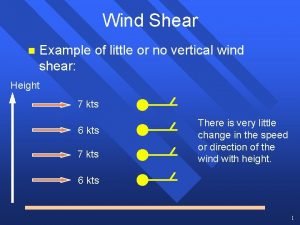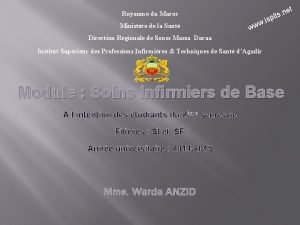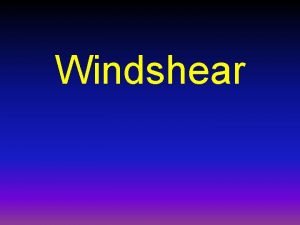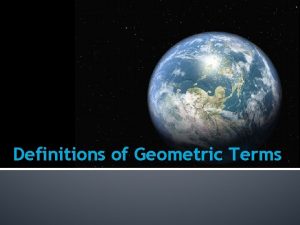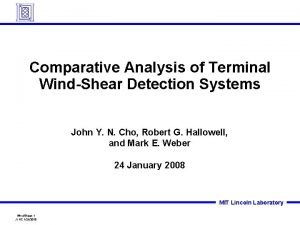Windshear Definitions Windshear is defined as variations in








- Slides: 8

Windshear

Definitions • Windshear is defined as: – variations in vector wind along flight path which, – causes abrupt displacement from the intended flight path such that, – substatial control action is required. • Low Level Windshear is: – windshear encountered during final approach, – along the runway, – along take-off flight path, – along the initial clmbout flight path.

Types of Windshear • Vertical Windshear: – change of horizontal vector wind with vertical change of aircraft position. • Horizontal Windshear: – change of horizontal vector wind with horizontal change of a/c position. • Down-draught Windshear: – change in the vertical component of the wind with horizontal change in position.

Main Causes of Windshear • CB/TS Activity: – see Section 8 of Met Notes. • Frontal Surfaces: – Warning signs are: • Sharp changes in wind direction. • Temperature difference of 5°C or more across a front. • Frontal speed 30 kt or more. – Cold front windshear is just behind surface position of front. – Warm front windshear is just ahead of surface position of front.

Main Causes of Windshear (cont. ) • Inversions: – A low level wind maximum occurs just below the top of a strong night time or frontal inversion. – The effect is sometimes to cause a decoupling of the surface wind from the prevailing gradient wind. – Thus air at the surface may be slow moving or stagnant and fast moving aloft giving a pronounced windshear across the interface. • See MET AIP 0 -9, 0 -10 insert at back of Met Practical notes.

Main Causes of Windshear (cont. ) • Turbulent Boundary Layer: – Strong surface winds with gusts and lulls produce horizontal wind shear. – Thermal turbulence in hot countries due to intense surface heating gives strong up/down draughts. • Topographical Windshear: – “Wind shadow” caused my topographical or man-made objects, • ravine winds • rotors • lee side wind of hills, tree lines.

Windshear Warnings & Reporting. • Warnings reported in following ways: – Met warning, – ATS warning – Departure/ Approach ATIS, – Pilot warning, – On-board equipment. • NOTE: Pilots encountering windshear on approach or climb-out are required to make a report to ATC as soon as possible even if previously encountered or f/cast.

Windshear Alerts • Issued when: – A marked temperature inversion of 10° or more exists between surface and 1, 000 ft. or – Mean surface wind exceeds 20 kt. or – Vector difference between mean surface wind and gradient wind at 2000’ exceeds 40 kt. or – TS or heavy showers are within 5 nm of airport.
